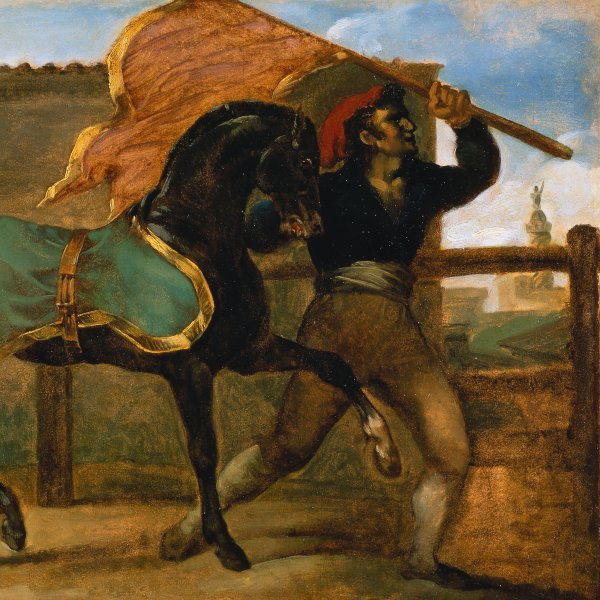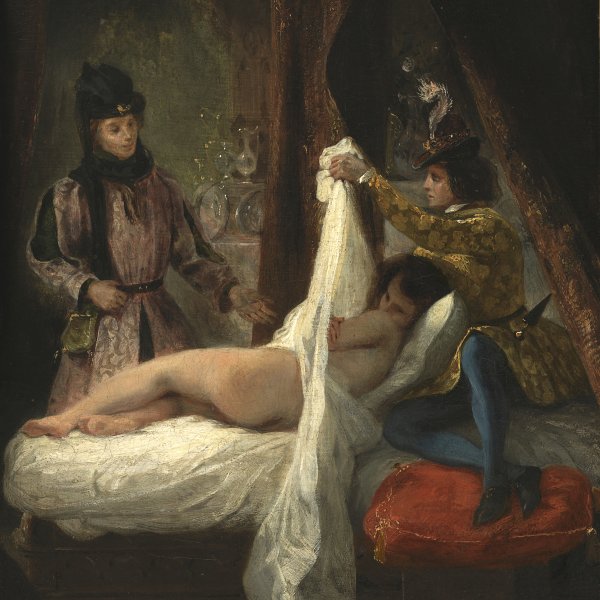The Kiss
ca. 1816 - 1817
Charcoal, wash and gouache on Brown paper.
20 x 27.4 cm
Museo Nacional Thyssen-Bornemisza, Madrid
Inv. no.
156
(1973.23
)
ROOM 29
Level 2
Permanent Collection
Having failed to win the Academy prize that would finance a study trip to Italy, in 1816 Géricault decided to visit that country at his own expense, arriving in September. He first studied in Florence where he lived for around one month then moved to Rome in November. In March of the following year he visited Naples and Paestum then returned to Rome. In September, a year after his arrival, he decided to cut short his stay and return to France. At this period Géricault drew incessantly, making sketches and producing a series of drawings on mythological and secular subjects of a notably erotic type. He drew groups of satyrs, centaurs and nymphs as well as traditional subjects such as Leda and the Swan and Venus and Cupid, as well as mortal couples. On occasions in these works Géricault conveyed a sense of violence in the amorous encounters through the figures’ gestures and their robust, muscular bodies of a type that recall Michelangelo and which indicate the influence of that artist on his work.
In the present scene, presumably set in an interior, the artist depicts a couple on a bed with large pillows and draperies that fall in swathes onto the floor. The seated man kisses and embraces a woman seen from the side, her body almost parallel to the picture plane. The artist used charcoal to define the outlines of the figures, emphasising areas such as the man’s neck, hand and leg nearest to the viewer and the woman’s waist. These strokes are more intense when they are used to construct essential areas of the bodies or shadowed areas such as the woman’s right side, her left arm and the outline of the lower part of her body. Pronounced white highlights are used to intensify the areas of light falling on the man’s torso, knee and leg and the woman’s breast. A lead-point study for this drawing is in the Musée Bonnat in Bayonne while there is a related oil in a private Swiss collection. Germain Bazin dated The Kiss to the same period as Couple embracing in the Musée du Louvre. In the present work Géricault also depicts the theme of the couple but places most emphasis on the man, who is depicted with a highly developed musculature and an almost Herculean pose. Nonetheless, he also conveys a lyrical note, conveying a sense of tender, human emotion not to be found in other similar images.
The drawing, which was previously on the US art market, entered the Thyssen-Bornemisza collection in 1973. Its provenance is known since 1846 when it was auctioned in Paris between 11 and 12 March. The Kiss was also in the collections of Richard Wallace, Christophe, and M. Groult. It was then with Francis Matthiessen in London and in the Norton Simon collection in Los Angeles.
Mar Borobia
In the present scene, presumably set in an interior, the artist depicts a couple on a bed with large pillows and draperies that fall in swathes onto the floor. The seated man kisses and embraces a woman seen from the side, her body almost parallel to the picture plane. The artist used charcoal to define the outlines of the figures, emphasising areas such as the man’s neck, hand and leg nearest to the viewer and the woman’s waist. These strokes are more intense when they are used to construct essential areas of the bodies or shadowed areas such as the woman’s right side, her left arm and the outline of the lower part of her body. Pronounced white highlights are used to intensify the areas of light falling on the man’s torso, knee and leg and the woman’s breast. A lead-point study for this drawing is in the Musée Bonnat in Bayonne while there is a related oil in a private Swiss collection. Germain Bazin dated The Kiss to the same period as Couple embracing in the Musée du Louvre. In the present work Géricault also depicts the theme of the couple but places most emphasis on the man, who is depicted with a highly developed musculature and an almost Herculean pose. Nonetheless, he also conveys a lyrical note, conveying a sense of tender, human emotion not to be found in other similar images.
The drawing, which was previously on the US art market, entered the Thyssen-Bornemisza collection in 1973. Its provenance is known since 1846 when it was auctioned in Paris between 11 and 12 March. The Kiss was also in the collections of Richard Wallace, Christophe, and M. Groult. It was then with Francis Matthiessen in London and in the Norton Simon collection in Los Angeles.
Mar Borobia









